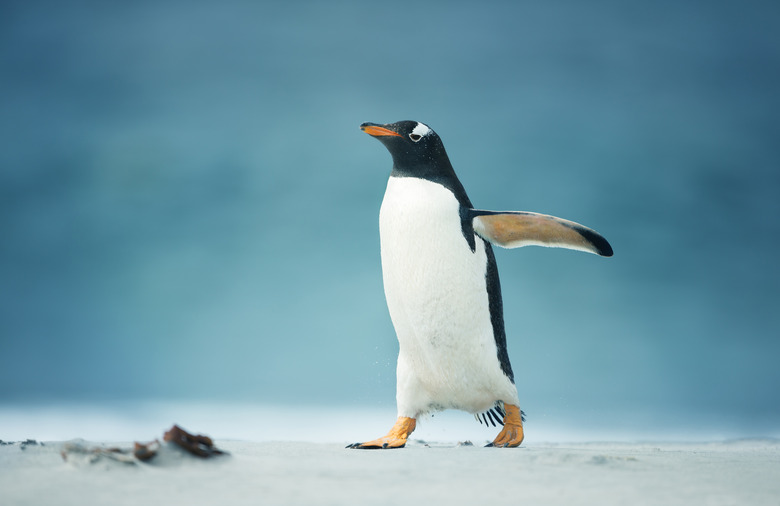About The Animals From Antarctica
The harsh conditions of Antarctica are responsible for there being no land-based mammals able to survive there. All of the animals found in Antarctica are either birds that have close ties to the ocean or mammals that spend the majority of their time in the water. The winter is so forbidding on this frozen continent that even some of these creatures will not try to endure its weather and migrate north to avoid it.
Penguins
Penguins
Penguins are birds that are flightless but have developed into exceptional swimmers, with some species capable of diving to depths of 700 feet in search of food. Penguins walk awkwardly on land and some will resort to lying on their bellies and pushing themselves along over the ice and the snow. In Antarctica, the largest penguins are the emperor penguins, which can weigh over 80 pounds and be as tall as 40 inches. These birds will stay throughout the year, actually laying their eggs in June when the winter is at its worst, with the male penguin keeping the egg warm while the female journeys back to the sea for food. The Adelie penguin is one of the most populous of the Antarctic penguins, with some 5 million of them located around the continent. They will go out to sea during the peak of winter, preferring to stay on the ice floes and icebergs. Penguins will eat such things as krill, squid, fish and crustaceans. Other species of penguins common in this region are the king penguin, the macaroni penguin, the chinstrap penguin and the gentoo penguin.
Seabirds
Seabirds
Scientists estimate that there may be as many as 100 million seabirds that breed along the Antarctic coast and on its neighboring islands. The albatross is a common bird of this part of the earth, including the wandering albatross, the world's largest flying bird. It has a wingspan of up to 142 inches and can weigh 20 pounds. It spends most of its time in the air and may go years without ever being on land. Petrels are another seabird found in great numbers in the Antarctic and eat carrion along with fish and mollusks. Skuas are fierce predatory birds that will kill and eat other birds, including the young of penguins. Gulls, terns and cormorants are other frequently encountered seabirds of Antarctica.
Seals
Seals
There are four types of seals that are commonly found on the Antarctic continent. The abundance of food and lack of predators such as the polar bear enable seals to thrive. The crabeater seal, the species of seal that has the largest worldwide population, is a fast moving seal on land even though it weighs as much as 500 pounds and despite its name it eats krill and not crabs. The Weddell seal is half a ton in weight and 9 feet in length and is able to dive as deep as 1,300 feet and remain underwater for as long as an hour. The rarely glimpsed Ross seal lives so far in the deep pack ice around Antarctica that little is known of its habits. The leopard seal is a spotted seal with sharp teeth; it hunts penguins and other seals and is considered a dangerous predator. Elephant seals and fur seals dwell on many of the islands in this cold region, but not on the mainland itself.
Baleen Whales
Baleen Whales
Baleen whales filter their food, which ranges from krill to tiny plankton, through baleen, which is a structure in their mouths that resembles a strainer. The blue whale is the largest animal on earth, weighing as much as 150 tons and sometimes being as long as 100 feet. It can eat almost 5 tons of krill in a single 24 hour period. Humpback whales perform acrobatics in the ocean, coming as much as two thirds out of the water and creating a great splash. The fin whale is known as being the fastest of the baleen whales and dives further down than any other whale. Other baleen whales that inhabit these southern seas are the southern right whale, the sei whale and the minke whale.
Toothed Whales
Toothed Whales
The two types of toothed whales found in the Antarctic waters are the sperm whale and the killer whale. The sperm whale can be 50 feet long, weigh 40 tons, and dive down as far as a mile. It eats giant squid, skates, fish, and octopus. The killer whale is actually the largest kind of dolphin. There are an estimated 160,000 of these intelligent marine mammals in the ocean around Antarctica. Killer whales hunt in packs and are capable of capturing and eating fish, seals, penguins, sharks, birds and even other whales. Like all whales in this portion of the globe the killer whale will migrate north once summer ends.
References
Cite This Article
MLA
Lindell, John. "About The Animals From Antarctica" sciencing.com, https://www.sciencing.com/animals-antarctica-5143099/. 22 November 2019.
APA
Lindell, John. (2019, November 22). About The Animals From Antarctica. sciencing.com. Retrieved from https://www.sciencing.com/animals-antarctica-5143099/
Chicago
Lindell, John. About The Animals From Antarctica last modified March 24, 2022. https://www.sciencing.com/animals-antarctica-5143099/
